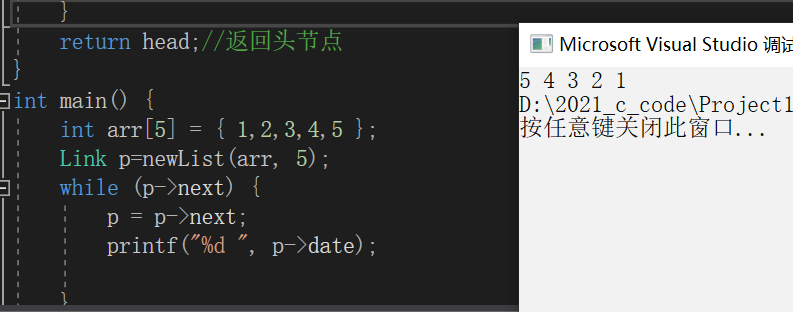catalogue
3: Find the number of elements in the single linked list
4: Insertion and deletion of single linked list and release of all nodes
1: Node creation
Create nodes through structures in c
Let's take the single linked list as an example and look at the following code. This is the structure type that creates a node
typedef struct node {//Structure creation
int date;//Data domain
struct Node* next;//Pointer field
}Node,*Link;//Alias. One is the structure type and the other is the pointer to the structure typeWe create a node through malloc to reference #include < malloc. H >
The return value of malloc function is void * universal pointer type. This pointer type cannot be operated and can be forcibly converted to any type
Since l1 is of Link type, it is converted to Link type
Link l1=(Link) malloc(sizeof(Node));//Create a node. The return value of malloc is void * and can be forcibly converted to any type
2: Traversal of linked list
It is easy to traverse the linked list by moving the pointer, but not p + +, because the linked list is logically continuous and physically discontinuous. Look at the following code. There is a header node here, and the next node of the header node stores data
void Display(Link l1) {//Traversal of single linked list
Link p = l1->next;
while (p) {//Determine whether p is empty
printf("%d ", p->date);
p = p->next;
}
}3: Find the number of elements in the single linked list
This is still traversal
int Num(Link l1) {//Calculate from the initial node. If you calculate from the initial node, count=1
int count = 0;
while (l1) {//Judge whether l1 is empty
l1 = l1->next;
count++;
}
return count;
}4: Insertion and deletion of single linked list and release of all nodes
insert
The precursor is easier to use than the successor. Ouch
The pointer points to the previous node of the inserted node, that is, the precursor

int insertNode(Link l1, int n, int x) {//l1 is the head pointer of the linked list, n is the insertion position, and x is the inserted data
int count = 0;//Record where the pointer went
Link p = l1->next;
while (p != NULL && count < n - 1) {//n is the insertion position. We need to move the pointer to the precursor position because the precursor ratio
//Subsequent easy to use [0-n-1] is n-1 number
p = p->next;
count++;
}
if (p == NULL) {//The linked list is not long enough
return 0;
}
else {
Link node = (Link)malloc(sizeof(Node));//Node to insert
node->date = x;
node->next = p->next;//Insertion algorithm
p->next = node;
}
return 1;
}delete
Two pointers need to be scanned one after the other until the previous pointer is scanned to the node to be deleted. Before scanning, judge whether the linked list is not empty

Link my_delete(Link head, int n) {
if (head == NULL || head->next == NULL) {//Judge whether the linked list passed in is an empty linked list
return 0;
}
Link p = head->next;//Initializes two previous and subsequent pointers
Link q = head;
while (p) {//Prevention of cross-border
if (p->date == n) {//If equal, delete
q->next = p->next;
free(p);
return 1;
}
else {//The two pointers move forward
q = p;
p = p->next;
}
}
return 0;
}Release all nodes
void my_free(Link head) {
while (head->next) {//Release if not empty
Link p = head;
head = head->next;
free(p);
}
free(head);//Release header node
}5: Implementation of single linked list (each time a new node is created, the next field of the node must be set to empty)
Head insertion
Suppose we have an array with n elements. We need to put the elements in a single linked list
The order of inserting elements by head interpolation is reversed
#include<stdio.h>
#include<malloc.h>
typedef struct node {
int date;
struct node* next;
}Node,*Link;
Link newList(int *arr, int n) {
Link head = (Link)malloc(sizeof(Node)) ;//Create a header node and make the pointer field null
head->next= NULL;
for (int i = 0; i < n; i++) {
Link node = (Link)malloc(sizeof(Node));//Each cycle creates a new node
node->date = *arr++;//Put the elements in the array into the data field of the node
node->next = head->next;//Set the pointer field of the node to null
head->next = node;//The head node points to the new node
}
return head;//Return header node
}
int main() {
int arr[5] = { 1,2,3,4,5 };
Link p=newList(arr, 5);
while (p->next) {
p = p->next;
printf("%d ", p->date);
}
}
Tail interpolation
Link newList2(int *arr, int n) {
Link head = (Link)malloc(sizeof(Node));//When creating a header node, set its pointer and to null before creating a node
head->next = NULL;
Link rest = head;//At the beginning, the tail node and head receive you in one position
for (int i = 0; i < n; i++) {
Link node = (Link)malloc(sizeof(Node));
node->date = *arr++;
rest->next = node;//Point the tail node pointer field to the new node
rest = node;//Point the tail node to the new node
}
rest->next = NULL;//Set the pointer field of the tail node to null, otherwise a wild pointer will appear, pointing to the unknown field
return head;
}